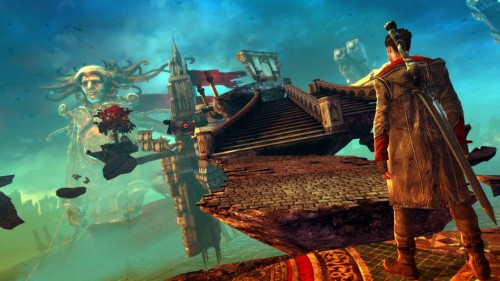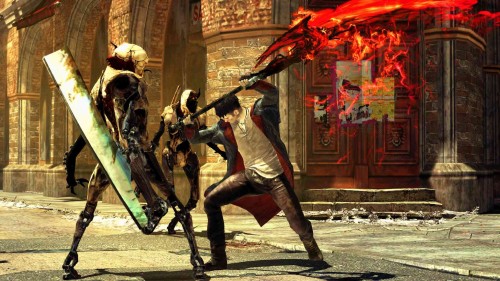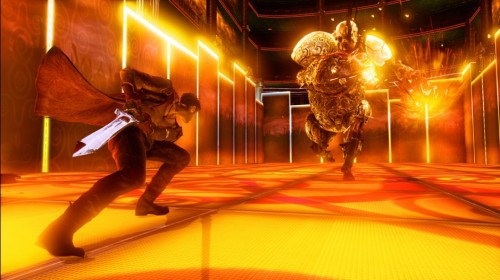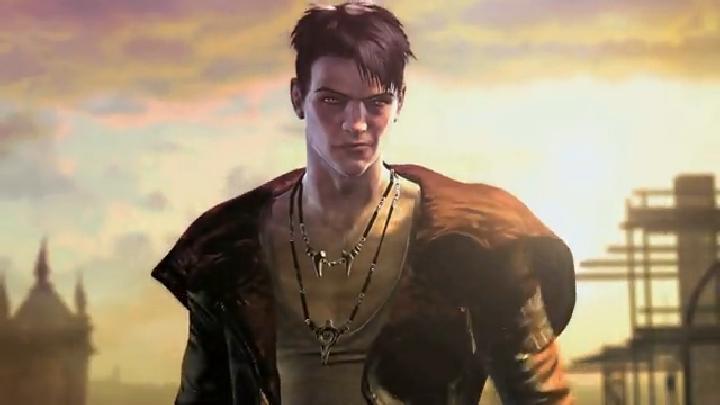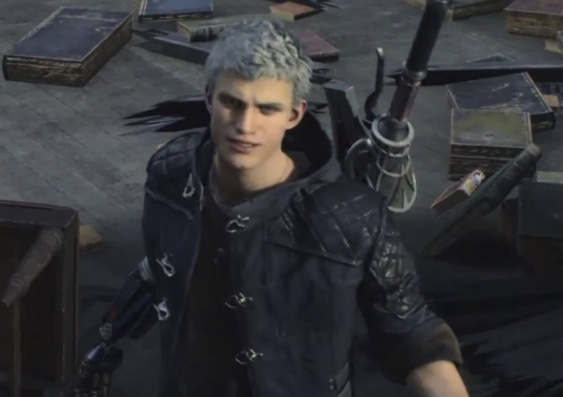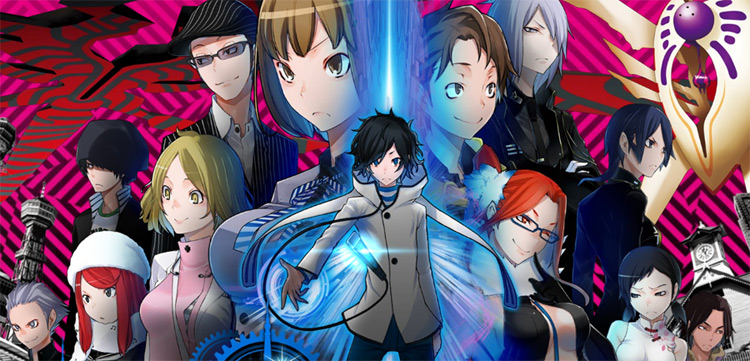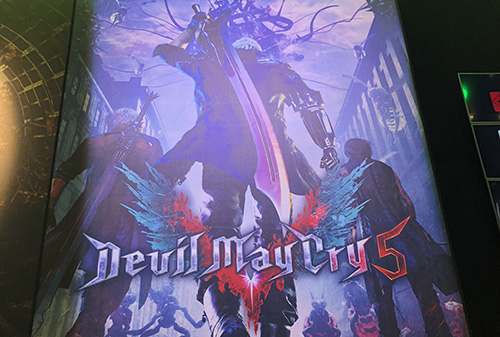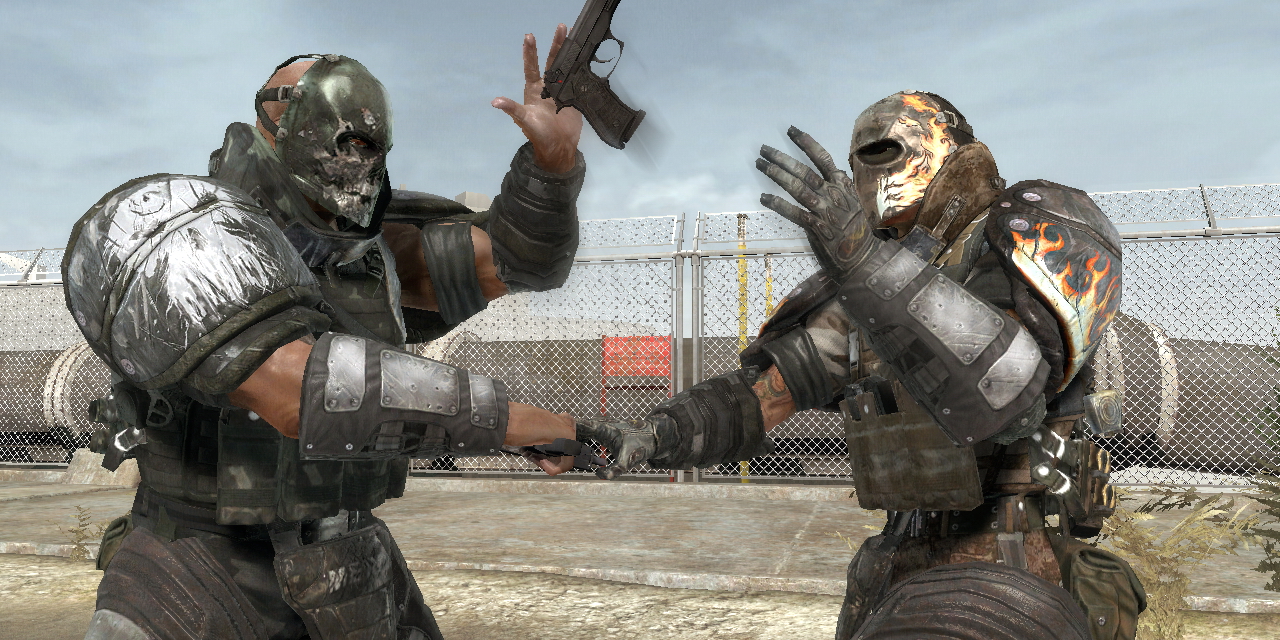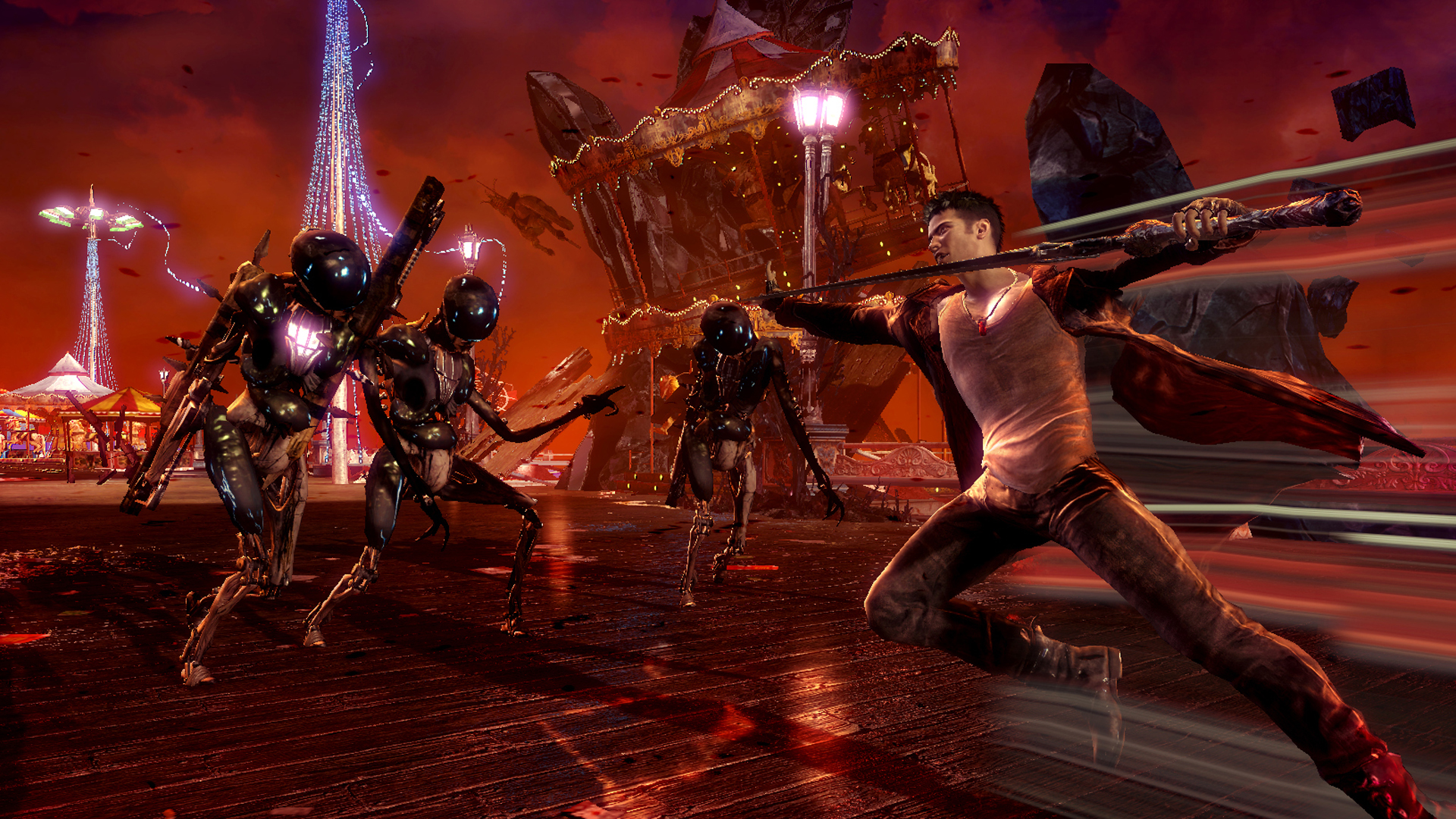
Adam G: DmC Devil May Cry is a reboot, and that means fans are going to be divided. Just take a look at the Star Trek reboot – that was four years ago, and still there are fans calling for JJ Abrams head on a silver pike. And for some Devil May Cry fans, too much has been changed in DmC for it to even be worth playing. But are they missing out? Developed by Ninja Theory, the purveyors of fine quality storytelling such as Heavenly Sword and Enslaved: Odyssey to the West, DmC eschews the series’ white-haired protagonist for a young playboy misfit on a journey to save the world from an alternate dimension of demons. Both Michael and I played the game, but while he played DmC on PS3, I got the massacre hell-spawn on my PC. So, Michael, how did you find this new take on Dante?
Michael: By way of necessary background, Adam, it’s important for me to be upfront and confess my crazy-love of the Devil May Cry franchise, barring the unfortunate second entry. The distinctive blend of stylish action, Gothic grandeur and ribald cheese spoke to me, and so it was with a healthy degree of shock and skepticism that I approached DmC. I was concerned to lose the idiosyncratic, inherently Japanese style of the franchise, and was afraid that I would miss the iconic character of Dante, who is surely one of the most self-referential, irreverent and memorable gaming protagonists of the last decade. I was right: I miss all of those things. But to properly judge Ninja Theory’s latest, I knew I had to approach it with an open mind, and regard it on its own terms, rather than be beholden to the history of the franchise and my own particular hopes and expectations. And so I did, and much to my surprise found DmC to be a terrific ‘character action’ game. For all that the series may have lost in the transition from old to new, it has gained much more, with Ninja Theory doing a surprisingly excellent job at re-imagining the series’ universe from the ground up.
While the game’s aesthetic purposely skews young with its ham-handed attempts at social commentary and depictions of teenage anti-establishment angst, the demonic world of Limbo and its twisting, surrealist landscape is captivating in its imagination and variety. Unlike previous entries which often ground to a halt by virtue of obtuse switch puzzles and backtracking through maze-like tunnels, DmC is constantly moving, transporting the player from set-piece to set-piece, from one gorgeous environment to another, and giving them new and imaginative to see. I literally couldn’t stop playing DmC, such was its hold on me – I always wanted to play just one more mission, just to see what was coming next. All of which is very fortunate, given that, for all of it’s good looks, Ninja Theory’s script often fails to rise to the occasion, with the story continually falling back on lame tropes and telegraphed plot-points. Did the narrative do anything for you?
Adam G: In many ways, the story of DmC feels like the Mortal Kombat reboot (which Australia never got). It cherry picks some of the best elements from the original series and works them into a new narrative – Dante’s family history, the arch-demon Mundus and, of course, Vergil. The dialogue rarely rises above the level of a cheesy action flick, and while the story didn’t necessarily keep me guessing, it did thoroughly entertain me. The elements that are present are executed well enough that I actually got a lot more invested in Dante as a character than I had before. I’m a little disappointed we never get to visit Dante’s eponymous shop, which has a history of having its entrance demolished by every visitor, but all the elements I’d want in a Devil May Cry narrative are here, and they didn’t even have to introduce a dumb new character and his sappy romance (Hello, Devil May Cry 4).
On the gameplay side, DmC retains the series’ signature stylistic action. Dante can slash his way through enemies, hurl them into the air and suspend them using the inexplicable power of demon bullets, and even grab them (without the use of a dumb neon arm, Devil May Cry 4). The more stylish your knockabouts are, the higher your ‘Style’ rating becomes, awarding you points to upgrade Dante’s abilities. However, for veterans the differences start with Dante’s new lineage. No longer half-demon/half-human, Dante’s mortal ancestry has been replaced by an angelic parent, and along with this comes a dichotomy in his arms. Using the left trigger, Dante can tune into his heavenly side and access a range of agile, quick weapons including a scythe and giant shuriken. The right trigger activates his demonic arsenal, replete with slow, powerful weapons like gauntlets and a massive spikey hammer. Previous games allowed you to switch between weapons on the fly as well, but the system here makes a lot of sense. The real kicker is that now lesser beings can experience the joy of achieving an ‘S’ or ‘SSS’ ranked combo, as the default difficulty level has been decreased substantially to a more pleasant (but enjoyable) level. How did the gameplay stack up against past games for you?
Michael: I wholeheartedly agree that DmC is skewed towards accessibility, providing beginners and intermediate players the opportunity to pull off flashy combos and experience some positive feedback – in many ways, DmC is a lot less tight and technical than its predecessors, but I don’t know that it matters. The combat in DmC is not any less entertaining than that of its forebears – simply different. The absence of a lock-on mechanic makes targeting foes with your guns difficult, and occasionally leads to frustration when trying to attack airborne foes, but by and large the fighting flows thick, fast and intuitively, and it’s never anything less than tremendously enjoyable. Perhaps the only significant criticisms that I can level at the action are the lukewarm boss encounters, which are few and far between but not very exciting beyond their gorgeous, inventive designs, and Ninja Theory’s apparent penchant for ‘gimmick’ enemies that require Dante to use either of his angelic or demonic weapons in order to defeat them (which sounds nifty in theory, but in practice results in the combat devolving into spamming one or two moves over and over with the mandated weapon). When Ninja Theory keeps it simple, which it does most of the time, the fighting really sings, and it was a true pleasure for me to constantly unlock new techniques and combos and fold them into my style of play. Beyond the combat, though, DmC does a good job of offering up some light platforming, which has never been a series’ strength, to vary the moment to moment experience. I found these traversal sequences pretty enjoyable, though, because they were seldom frustrating and were always gorgeous to behold. I also really admired the way in which Ninja Theory laid out its bevy of secret items and side-missions, many of them being locked behind doors or secret passages which are only accessible upon returning to the area after acquiring a new weapon or technique. This light exploration element gives DmC some variety, and offers up one of many tantalising reasons to play through the game a second or third time. It may be a short and none-too-difficult game, clocking in for me at 10 hours on ‘Nephilim’ (the hardest difficulty available on my first run) but it’s one that I see myself returning to again and again to clean up all of the remaining doodads and hidden difficulty levels.
Adam G: Agreed – on the regular difficulty, DmC will only last you about 6-7 hours, but you’ll rarely be faced with having to repeat lengthy sections due to death or failure.
Hotly debated among Devil May Cry fans, though, is the game’s technical performance, and how it may or may not have affected the core gameplay. On PS3, the game runs at fairly consistent 30 FPS, while on PC the game is substantially smoother, rarely falling below 100 FPS for me on my god-tier gaming rig. Combat was smooth and reasonably responsive, although this could be partly due to a new ‘input buffering’ system in place, inherited from the fighting genre, which allows you to stack commands to a certain extent to keep combos flowing. Did the framerate and technical performance of the PS3 version affect your appreciation of the gameplay at all?
Michael: I found the experience perfectly playable on the ageing PS3, Adam, and I suspect that for the vast majority of players, the game’s framerate won’t be a critical issue. Ninja Theory has copped a lot of flak for adopting the Unreal Engine and aiming for the ‘feel’ of 60 FPS, but in the end the developer has delivered a game which largely delivers on that promise. It’s immediately apparent that DmC has been built from the ground up to be playable at 30 FPS, and I never encountered a sequence where my performance felt impeded on account of a lack of responsiveness. By offering up a broader, slightly looser, and more accessible combat engine, DmC neatly sidesteps the need for a higher framerate. I also thought that the clever use of motion blur gave the game a (dare I say it?) ‘cinematic’ feel in line with the game’s presentation. While I couldn’t recommend that players choose the PS3 version of DmC if they have a PC capable of running it, I am confident in saying that console stalwarts will find little to complain about, save for some dubious loading times between levels and some choppiness during the frequent cinematics.
While I could break DmC down to its granular elements and level minor criticisms against some of its component parts, my overall experience with the game was really pleasurable, and very surprising. To my mind, DmC is not only Ninja Theory’s greatest achievement, but also a highlight of the franchise (if not one of its best entries) and a portent of great things to come. This is a friendlier, more mainstream Devil May Cry than what most players are used to, but for everything the series appears to have shed in the transition from East to West, it has also gained much. Ultimately, DmC is not a vast improvement or downgrade for Devil May Cry; instead, its a fundamental shift in alignment. While some will find the metamorphosis difficult to swallow, those who are prepared to open their minds and appreciate DmC for what it is will find the best action game released in many years. I don’t know for sure, but I suspect we might be in agreement on this one, Adam. What say you?
Adam G: All I can say is that the thought of another Devil May Cry after the fourth entry in the series just didn’t elicit any kind of excitement from me. The series had given its best in the third game, and where could Capcom really go from the fourth? Could they really just recycle the same self-parodying schtick? DmC Devil May Cry is, as you point out, a positive shift into something fresh, vibrant and engaging. It mightn’t get everything right on the first try, but it’s a really fun and confident step in a new creative direction for the series, and it’s got me more invested in future Devil May Cry titles than I have ever been before.
Inventive, Twisted Level Design | Satisfying, Intuitive Combat | Unlockable Difficulty Levels and Hidden Secrets
Lacklustre Boss Encounters | Some Hamfisted Social 'Commentary' | Occasional Choppiness on PS3

